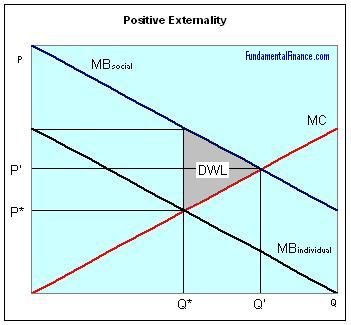WHAT IS THE BASIC FUNCTION OF THE GOVERNMENT?
-The government has a monopoly on violence, in order to keep society from dissolving into violent anarchy (in countries where the government does not have a monopoly on violence, anarchy and civil unrest make like very difficult- just think of Somalia, or Afghanistan)
-Because the government has this monopoly on violence, they can enforce property rights laws, and prevent people for stealing other people's property
-The government's main job from an economist's perspective, then, is to enforce property rights
-By enforcing property rights and maintaining stability, governments allow for economic activity and prosperity.
OKAY!
So, for most of this course, we have been focusing on how the market works. In most of the cases we have explored, an economy regulated by the invisible hand of the market leads to the best possible outcome for society. This chapter will examine certain situations where markets fail to provide the best possible outcome for society, and how the government can intervene to correct this. We're also going to look at some inherent problems with government intervention.
Basically, when looking at any economic situation, we should ask ourselves:
-"Is the market working or failing"
-"If the market is failing, what is the optimal level of government
Markets are working best when they are allocatively efficient. Competitive markets are allocatively efficient:
-Competitive Markets use marginal cost pricing, so the price is set at the marginal cost of producing the last unit
-Competitive Markets minimize price and maximize the quantity produced
-Competitive Markets maximize economic surplus
If all markets were perfectly competitive, then the economy would be allocatively efficient. This is a pareto optimum, and neither producers not consumers would be able to add to their own surplus without causing the other to lose surplus.
PROBLEM: Most markets aren't perfectly competitive!
Here is an informal defense of natural market forces- why governments should usually just let the economy run itself.
-Free markets are automatic, flexible, and decentralized
-The price system acts like an invisible hand, regulating the market: demand affects price, which in turn, affects supply.
-There is no need for inefficient, centralized planning
-The pursuit of profits stimulates innovation and economic growth
-Power is naturally challenged through competition and innovation, so it is ultimately difficult for monopolies to exist indefinitely.
-Milton Friedman argued that economic freedom is essential to political freedom (which makes sense: if you don't have enough money to afford a house or fixed address, then you can't vote).
--------------------------------
INSTANCES OF MARKET FAILURES: Sometimes we do need the government to intervene. Sometimes, intervention is a waste of public funds. Many of the services which the government provides are, according to our prof, unnecessary and wasteful.
---------------------------------
MONOPOLIES:
-Monopolies and monopolistic competition have downward-sloping demand, so they are allocatively inefficient.
-This is due to barriers to entry
-The government usually does not obliquely try to eliminate monopolies. Instead, they either punish monopolies with regulation, or they try to create a level playing field with competition policy
-Governments can intervene in monopolies to make things more allocatively efficient
EXTERNALITIES: Non-priced costs or benefits which affect third parties
-This refers to the results of economic functioning which effect people other than the buyer and the seller (for an example, if you buy a coat of paint for your house, and then paint the ugly front of your house to make it look nicer, this creates an external benefit for your neighbor, whose property values probably will increase as a result).
-EXTERNAL ECONOMIES are external benefits, such as the added benefit your neighbor receives when you paint your house
-EXTERNAL DISECONOMIES are external costs, such as pollution or second-hand smoke.
-PRIVATE COSTS are the costs to the buyer or seller (this includes opportunity cost)
-SOCIAL COSTS are the combined external costs and private costs of any economic decision. This is the opportunity cost to society.
Externalities create unrecorded discrepancies between private costs and social costs, and result in allocative inefficiencies on a societal level

Negative externalities can be treated like an extra cost, and thus shift supply to the left!
This means that when there are negative externalities which are not taken into account, usually an economy is overproducing at too low a price. By raising prices and scaling back production, these economies can become allocatively efficient

Positive externalities can be treated like an addition to demand, and this they shift demand to the right!
This means that when there are positive externalities which are not taken into account, usually an economy is underproducing at too low a price. By increasing production and raising prices, these economies can become allocatively efficient.
Governments can correct externalities by forcing corporations to pay for negative externalities as an added cost.
APPLICATIONS OF EXTERNALITIES:
Here are some negative externalities which are fairly well known
-Nuisance externalities (pollution is considered a nuisance in legal terms)
-Open access resources (eg: fish in the Fraser river. There is a negative externality, in that catching the fish depletes fish stocks and reduces the availability of fish in the future).
-Congestion of highways (The fact that cars take up space on the highway is not taken into account, so even though it doesn't cost to use the highway, a negative externality is created from the frustration and irritation of having to deal with too many extra drivers)
-A famous example is the tragedy of the commons. In olden days when peasants still had commons land where they could let their animals graze, many peasants failed to take into account the cost of maintaining the grass and animal food supply of the commons. As a result, they overused the commons, and eventually all of the natural animal food become depleted, so the livestock died of starvation. This is an example of overproduction (overuse of the commons) due to a failure to factor external diseconomies into social costs.

PUBLIC GOODS: Sometimes, governments must intervene in order to provide society with a specific kind of good which markets cannot provide. Here are the characteristic of a pure public good:
1: It must be non rivalrous- in other words, consuming this good will not reduce the ability of others to consume this good (a good example of this is information-- gathering information from a sources does not hinder anyone else from gathering that information (unless you are stealing library books or something stupid like that)
2: Non excludability- If this good is produced, it must be a product which can be consumed equally by all- there are no restrictions in who is allowed and not allowed to use the good (so within the context of Gateman's class, the lecture itself is non-excludable. Everyone in the class is equally able to listen to the lecture and learn about economics from it). Example here include a lighthouse, or national defence.
Normal Goods: Rivalrous and Excludable-- This includes most goods which are sold on a market, such as chocolate bars, legal advice, plane tickets, etc. Governments can let markets take care of the distribution of normal goods. The market works here!
Common Property Goods: Rivalrous and Non Excludable-- This includes goods which anybody can access, despite their being a limited supply of the good. Examples include camping sites, or fish stocks. Often, common property goods suffer from the tragedy of the commons, and are overused because negative externalities are not factored into private costs. The market fails due to external diseconomies here!
Psuedo Public Goods: Non-Rivalrous and Excludable-- This includes goods which do not deppreciate when consumed, but which are distributed in such a way that some people are excluded from using them. Examples include art galleries, day care, roads, public parks, education, and others. The fact that these are non-rivalrous implies that supply is always greater than demand, so this excess supply will often push the price of a quasi public good down to zero. Often, the government provides these as merit goods. The market fails due to $0 price demanded, here!
Pure Public Goods: Non-Rivalrous and Non Excludable-- These are goods which do not deppreciate with use, and which are accessible to everyone. This includes things like national defence, a ligthouse signal, public information, and public protection. The free rider problem means than consumers usually will not reveal their price preferences, because they would rather someone else pay for the pure public good (everyone wants a free ride). As such, the government must use taxation to force everybody to pay for this good, or else, the good will not be produced. As such, we need the government to intervene. The market fails due to the free rider effect here!
So we need the government to intervene!
ASYMMETRY OF INFORMATION: This is where the buyer and the seller have different levels of knowledge about a particular good
a MORAL HAZARD, is an example of assymetry of information where one party has the ability and incentive to shift costs onto the other party due to some special knowledge which they posess (for example, a car mechanic could trick you into getting expensive work done on your car which you don't need). Another example is a used car salesman inflating the price of a used car.
ADVERSE SELECTION is an example of assymetry of information where "self selection" adverse affects the group. Because people who are poor drivers are more likely to purchase insurance, and isurance companies often have no way of evaluating each customer's driving abilities, poor drivers increase the overall cost of insurance at the expense of good drivers. Similarly, people who are unhealthy pay the same medical premiums as everyone else, yet cost the medical system much more money. Here, there are negative externalities created by adverse selection. The private cost to a smoker for using the hospital is less than the social cost of that hospital visit.
THE PRINCIPLE AGENT PROBLEM: Where top employees for a company seek to maximize revenues (and their own salaries) at the expense of net profits. Here, marginal social benefits and marginal social costs are not equated, so the firm is inefficient.
THUS WE HAVE A CASE FOR GOVERNMENT INTERVENTION
OTHER SOCIAL GOALS: Sometimes, governments seek to intervene for reasons other than market failures! Here are some of them
-Income redistribution (many people think this a fairer way of allocating wealth. Professor Gateman thinks its just a throwback to communism)
-Merit Goods: The government provides goods which are not pure public goods based on their Merit to society (eg: Healthcare and education). They cold technically also be provided by private groups.
-Social obligations (eg: jury duty, conscription, voting, etc.)
-Economic Growth (research and developement)
That's all for now!











